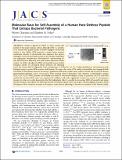| dc.contributor.author | Chairatana, Phoom | |
| dc.contributor.author | Nolan, Elizabeth Marie | |
| dc.date.accessioned | 2017-05-23T14:34:05Z | |
| dc.date.available | 2017-05-23T14:34:05Z | |
| dc.date.issued | 2014-08 | |
| dc.date.submitted | 2014-06 | |
| dc.identifier.issn | 0002-7863 | |
| dc.identifier.issn | 1520-5126 | |
| dc.identifier.uri | http://hdl.handle.net/1721.1/109287 | |
| dc.description.abstract | Human α-defensin 6 (HD6) is a 32-aa cysteine-rich peptide of the innate immune system. Although HD6 is a member of an antimicrobial peptide family, it exhibits negligible antibacterial activity in vitro. Rather, HD6 possesses a unique innate immune mechanism whereby it self-assembles into oligomers that capture pathogens to prevent microbial invasion of the intestinal epithelium and subsequent dissemination. Molecular-level understanding for why HD6 functions differently from other human defensins remains unclear. To further elucidate the HD6 self-assembly process and its biological activity, we developed robust protocols for obtaining native and mutant HD6 in high purity from overexpression in Escherichia coli. We combined biophysical characterization with biological assays to probe HD6 structure and function. We report that native HD6 readily self-assembles into elongated fibrils observable by transmission electron microscopy, agglutinates both Gram-negative and -positive bacteria, and prevents the human gastrointestinal pathogen Listeria monocytogenes from invading cultured mammalian cells. Mutation of hydrophobic residues (F2A, I22T, V25T, F29A) perturbs self-assembly and results in attenuated biological activity. In particular, the F2A and F29A mutants do not form fibrils under our experimental conditions and neither agglutinate bacteria nor prevent L. monocytogenes invasion. In total, our results demonstrate that the hydrophobic effect is essential for promoting HD6 self-assembly and innate immune function, and indicate that HD6 may provide host defense against Listeria in the gut. This investigation provides a timely description of how variations in amino acid sequence confer diverse physiological functions to members of the defensin family. | en_US |
| dc.description.sponsorship | United States. National Institutes of Health (DP2OD007045) | en_US |
| dc.language.iso | en_US | |
| dc.publisher | American Chemical Society (ACS) | en_US |
| dc.relation.isversionof | http://dx.doi.org/10.1021/ja5057906 | en_US |
| dc.rights | Article is made available in accordance with the publisher's policy and may be subject to US copyright law. Please refer to the publisher's site for terms of use. | en_US |
| dc.source | ACS | en_US |
| dc.title | Molecular Basis for Self-Assembly of a Human Host-Defense Peptide That Entraps Bacterial Pathogens | en_US |
| dc.type | Article | en_US |
| dc.identifier.citation | Chairatana, Phoom and Nolan, Elizabeth M. "Molecular Basis for Self-Assembly of a Human Host-Defense Peptide That Entraps Bacterial Pathogens." Journal of the American Chemical Society, 136, no. 38 (August 2014): 13267–13276 © 2014 American Chemical Society | en_US |
| dc.contributor.department | Massachusetts Institute of Technology. Department of Chemistry | en_US |
| dc.contributor.mitauthor | Chairatana, Phoom | |
| dc.contributor.mitauthor | Nolan, Elizabeth Marie | |
| dc.relation.journal | Journal of the American Chemical Society | en_US |
| dc.eprint.version | Final published version | en_US |
| dc.type.uri | http://purl.org/eprint/type/JournalArticle | en_US |
| eprint.status | http://purl.org/eprint/status/PeerReviewed | en_US |
| dspace.orderedauthors | Chairatana, Phoom; Nolan, Elizabeth M. | en_US |
| dspace.embargo.terms | N | en_US |
| dc.identifier.orcid | https://orcid.org/0000-0002-5356-3638 | |
| dc.identifier.orcid | https://orcid.org/0000-0002-6153-8803 | |
| mit.license | PUBLISHER_POLICY | en_US |
| mit.metadata.status | Complete | |
